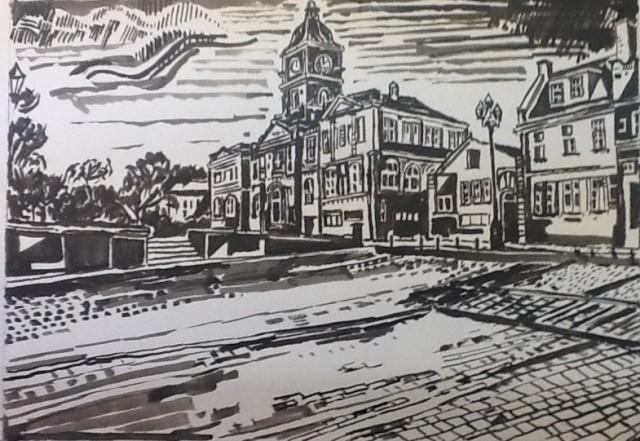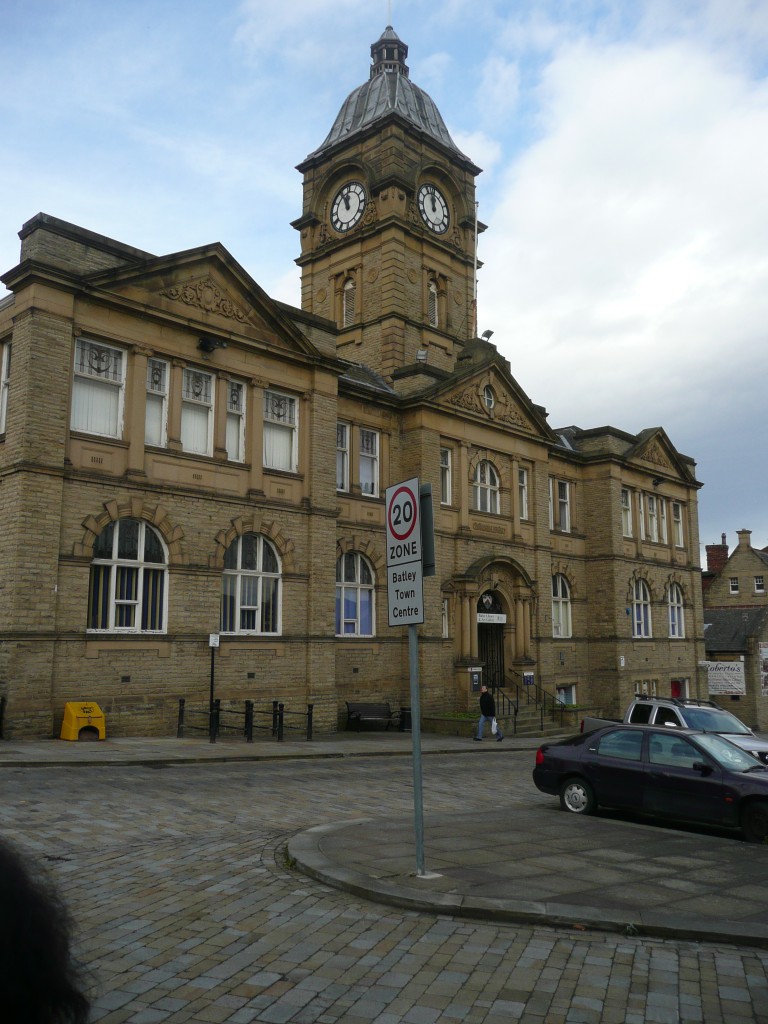Essentially I am a painter who also enjoys making prints. This affection for printmaking grew at art college where the much loved and renowned teacher Kass Cohen introduced me to a range of processes and latterly gave me some of his lithographs which were made in Paris after the war.
At the Slade I was interested to hear Philip Sutton extol the virtues of printing without a press and specialist materials, and saw him make silk screen prints using Rowntrees Jelly as a barrier. In my own work for the past six years or so I have started to make woodcuts. I don’t have a press and so tend to hand burnish them, using the handle of a burin or the back of an engraving tool. It is an activity which I can do at home at the back of the house when it is too dark to paint.
In October I took my wife Cris to Yorkshire to visit the small industrial town where I spent my formative years before coming down to London to attend art college. Batley had been a bustling town which had grown rich by recycling old cloth and making new cloth from old, a process called “shoddy”; this I have to say is nothing to do with quality, just good old northern know how and thrift. All the women in my family worked as weavers or finishers at J T & J Taylors Mill in Batley. The men historically were miners, or worked in industry supporting the pits, but Dad was encouraged to “get some learning” and became a teacher. It was with some excitement that we set off. Most of the town was as I remembered, with the exception of Commercial Street were the shops were. The Market Place, Library and Post Office were still there, though the latter was now a restaurant.
I made drawings of the Market Place, the first I had ever made of Batley, and the Market Place and Library was to form the subject of a new woodcut. I’m not sure if I make my prints in an orthodox way, but this is how I made the print of Batley Market Place.
Initially I made an ink drawing. I like to draw in ink, brush and pen because it gives you an idea of the black and white distribution which will appear on the print.
I will then lightly brush black pen ink onto the surface of the block. Then I trace out the ink drawing and cover the block with a white transfer paper and on top of this carefully place the tracing. After lightly pressing the outlines and areas I want to be white, I will remove both paper layers, to reveal a silvery image on the darkened block. I can then cut away with my wood cutting tools everything I want to remain white in the final print.
Now I can print. I ink up the block, I use a good roller which is smaller than the block, and black printing ink.
I can now place paper on the inked block and having made a clean initial contact use a burin’s smooth wooden handle to encourage the ink from the block onto the paper. Depending on the inking and the size of the block this can be a lengthy and strenuous process. The joy comes when you pull a clean even print from the block.
With this print I decided to have it editioned professionally, so I went to see David Borrington at Dekkle Print in Hertfordshire, a small fine print studio.
Batley Library & Art Gallery, where I did all my revision and in the Art Gallery aged eleven I saw my first real paintings, an exhibition of Kitchen Sink paintings which had a real impact. Jack Smith’s interiors and Bratbys. I think the gallery in a small northern town was on the Arts Council touring exhibition circuit.
Paul Finn / The Rowley Gallery




![Making_the_print_032[1]](http://cdn.rowleygallery.co.uk/2012/01/Making_the_print_0321-1024x768.jpg)
![Making_the_print_042[1]](http://cdn.rowleygallery.co.uk/2012/01/Making_the_print_0421-1024x768.jpg)
![Making_the_print_003[1]](http://cdn.rowleygallery.co.uk/2012/01/Making_the_print_0031-662x1024.jpg)
![Making_the_print_006[1]](http://cdn.rowleygallery.co.uk/2012/01/Making_the_print_0061-579x1024.jpg)
![Making_the_print_009[1]](http://cdn.rowleygallery.co.uk/2012/01/Making_the_print_0091-e1327793739361-768x1024.jpg)
![Making_the_print_057[1]](http://cdn.rowleygallery.co.uk/2012/01/Making_the_print_0571-1024x768.jpg)
![Making_the_print_058[1]](http://cdn.rowleygallery.co.uk/2012/01/Making_the_print_0581-1024x768.jpg)
![Making_the_print_060[1]](http://cdn.rowleygallery.co.uk/2012/01/Making_the_print_0601-1024x768.jpg)

Great stuff Paul. You have infused the square at Batley with all the charm and energy that packs in to the combination of memory and experience. Kass would have loved it and even now will be smiling at the prospect of you making these superb prints.
As a Lad born in Batley 47 years ago, I really enjoyed Paul’s print of Batley Market Place. As an apprentice painter and decorator I painted the hands and numbers of the clock in the clock tower in the photo above! That building is also a Carnegie library built in 1907. I also had the please of painting it’s ornate interior as an apprentice.
Thanks for the trip down memory Lane Paul.
Matthew Tingle
Very informative and succinct. Good to see you are getting your hands dirty, Paul. Nice work!
More ‘Heavy Woollen District’ woodcuts now please?……
Thank you Paul for pointing me in the right direction. It is fascinating to be able to see you work and as an ex printer, a compositor to be precise, to see you pulling the old Albion Press. I am not sure the public really appreciate what goes into making such good prints.
Paul, such fantastic images of you, Cris and Batley. I remember fondly the torchlight procession from St Mary’s church through the town and to the market place every October.I am the very proud owner of the first print and a very beautiful piece of work. Thank you
Hi Paul
I found your explanation of the process really interesting and I must say Anne and I are really pleased with our copy of Batley which holds lots of memories for her.
Also, whilst showing it to Joseph recently whom you have inspired to focus on his drawing he remembered that you are going to send him one of your drawings – children seldom forget!
Well done Paul fantastic work.
Dave
Very interesting. How does one obtain a copy of the print?
Thank you Anne. Prints are on sale at The Rowley Gallery.
Thanks for your post Anne. The Rowley has a Batley print nicely framed.
Paul Finn
Hi Paul, What is the address of the Rowley and where is it.? How do I order a print?
You can contact The Rowley Gallery at info@rowleygallery.co.uk